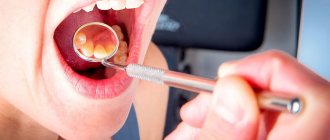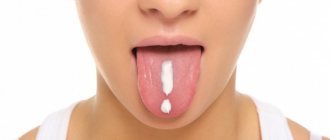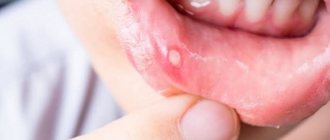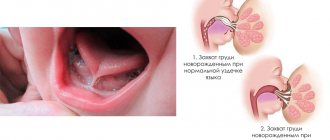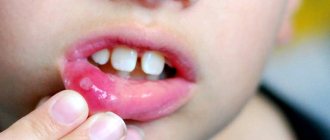Stomatitis can be recognized by multiple ulcers on the gums, tongue, palate, inner cheeks and lips. It all starts with redness, which is accompanied by a burning sensation or a slight tingling sensation, and only after that, in places where pathogens are most concentrated, an ulcer forms. As a rule, it is shallow, and nevertheless, at the slightest irritation - while eating or brushing teeth - it makes itself felt with severe pain. But don’t despair; with proper treatment, stomatitis can be defeated in 4-5 days. Chlorhexidine for stomatitis is one of the mouth rinses recommended by all doctors.
Symptoms of aphthous stomatitis
Aphthous inflammation goes through several periods in development:
- prodromal, or the period of harbingers of the disease;
- the period of rashes when aphthae appear;
- period of extinction or recovery 3.
Premonitory symptoms:
- itching and burning in the area of the affected area of the oral mucosa (sometimes several days before the appearance of aft5);
- appearance of a pale or red spot on the mucous membrane5;
- slight swelling at the site of inflammation3;
- mild short-term pain, most often occurring when brushing teeth or eating food3.
- Possible symptoms of malaise: slight increase in temperature, weakness, headache5.
After a few hours, aphthae (the stage of rashes) form in the place of the mucous membrane where discomfort was felt. Most often, these are round or oval ulcers up to several millimeters in size5,6, with a red rim on the outside and a bottom covered with a grayish-white fibrinous coating4. However, in some cases, inflammation extends into deeper layers of tissue and appears as an area of necrosis (tissue decay)6.
Aphthae can appear anywhere, but more often on the inner surface of the lips and cheeks, in the area of transitional folds between the lower and upper jaw, on the lateral surface and back of the tongue3. With aphthous stomatitis, 1-2 aphthae are most often formed, but sometimes their number is much larger, and then the disease is severe5. Excessive salivation aggravates the situation5, forcing you to constantly swallow or spit out viscous saliva.
The recovery stage is characterized by gradual healing of aphthae. Superficial ulcers heal within 5-7 days and leave no trace behind, deep ulcers - within 2-3 weeks, with the formation of scars that deform the mucous membrane4.
Up to contents
Advantages and disadvantages of the drug
Due to its high antimicrobial activity, chlorhexidine is often used in dentistry. It is cheap and effective - these are its main advantages. But the coin also has a downside. In addition to the fact that rinsing is unlikely to give the patient a pleasant sensation (the solution has a pronounced bitter taste), they can also stain the teeth and tongue brown.
The fact is that blackening is a reaction of microbes to the active substance. Where the accumulation of microorganisms is most abundant, dark spots appear. However, you can easily get rid of them by making an appointment with your dentist for tartar cleaning. But even if this is not done, after a few days after completing the course of rinsing, the darkening will go away on its own.
It must be said that not all dentists prescribe chlorhexidine for stomatitis. Some doctors generally believe that the effectiveness of this drug in the treatment of ulcerative inflammation of the mucous membrane is zero. They argue their position by the fact that 9 out of 10 stomatitis are caused not by bacteria, but by viruses, in particular herpes viruses. And if chlorhexidine fights microbes with a bang, then it is practically powerless against viruses.
Of course, there is also an aphthous form of the disease, but it is usually the result of a local allergic reaction, vitamin deficiency or injury (burn, scratch, cut), and therefore it is not treated with antiseptics. They can be used for only one purpose - to prevent bacterial infection from joining the foci of erosions and ulcers. If we are talking about the herpetic form of stomatitis, then it is appropriate to use another antiseptic - Miramistin, which can affect not only bacteria, but also viruses.
So you shouldn’t place too much hope on recovery by doing just rinsing. Chlorhexidine is effective only as part of complex therapy and only after deposits of stones and plaque have been removed from the oral cavity. Treatment of stomatitis is often impossible without taking antihistamines and antifungals, and in some cases without antibiotics.
Dentists warn
By trying to suppress inflammation with an antiseptic, patients are doing themselves a disservice. Until the cause of the inflammation is determined and eliminated, it will develop one way or another, only with less pronounced symptoms. The result of such amateur efforts can be sad: when the patient does get to the doctor (and this is inevitable), the only way out of this situation may be the removal of loose teeth.
Note! Like any medical product, chlorhexidine has an expiration date. You cannot rinse your mouth with a solution that has been stored in your medicine cabinet for more than 2 years. Moreover, even if you are sure of the date, make sure that all this time the packaging was stored correctly (at a temperature not exceeding 25 degrees) and was not exposed to direct sunlight.
Types of aphthous stomatitis
Aphthous inflammation of the oral mucosa occurs:
- sharp;
- chronic recurrent1.
Acute inflammation of the mucous membrane in 70% of cases is observed in children under the age of 3, less often up to 6 years. More often it occurs as an acute infectious disease, with its characteristic sudden onset and symptoms of intoxication1.
Chronic recurrent aphthous stomatitis is more common in adults, and is equally common in men and women1. Despite treatment, aphthae appear from 1-2 to 6-8 times a year, more often in spring or autumn8, and no symptoms are observed between these episodes2,3.
Up to contents
Causes of aphthous stomatitis
Aphthous inflammation is classified as an infectious form. Its development is associated with the impact on the mucous membrane of various bacteria, viruses and fungi7. Some researchers consider adenoviruses to be the causative agents of aphthous stomatitis, others blame staphylococcus5.
The causes of the chronic form of the disease still remain unclear. The autoallergic nature of inflammation is assumed, in which the oral mucosa becomes a target of its own immunity3,5.
There are known factors that predispose to the development of a chronic process:
- allergies: allergens include food products, oral hygiene products, dust, helminths, medications3;
- diseases of the gastrointestinal tract4,5;
- foci of chronic infection in the body: chronic tonsillitis, pharyngitis, otitis media, etc.3,4;
- respiratory infections3;
- functional disorders of the nervous system3,6;
- lack of vitamins B1, B12, C and iron3;
- chronic stress4;
- occupational hazards4;
- genetic predisposition 3.5.
Up to contents
When else is chlorhexidine used for teeth?
After tooth extraction
Stomatitis is not the only reason to resort to the help of an antiseptic. Its antimicrobial properties can be very useful after a complex tooth extraction. Especially if the surgical intervention took place against the background of inflammation or not all deposits of tartar and caries have been removed from the oral cavity. To prevent the infection from seeping into the hole formed at the site of the removed molar and causing the blood clot there to suppurate, the surgeon may recommend an antiseptic.
How to rinse your mouth with chlorhexidine after tooth extraction? Not too active and not too long. Simply hold the solution in your mouth for 20-30 seconds. The main thing is to prevent a blood clot from falling out of the hole. Then repeated bleeding may begin and the risk of inflammation will be too high.
In this case, we may be talking about another diagnosis - alveolitis. It also involves rinsing with an antiseptic, but only after the inflamed contents of the hole have been thoroughly cleaned of necrotic residues, washed and treated with a medicinal solution. All these manipulations are carried out by a surgeon and only he can give recommendations on further rinsing with chlorhexidine.
During teething
Chlorhexidine digluconate solution is often indispensable in dental practice. Thus, it helps relieve inflammation that occurs when wisdom teeth erupt. Until it is completely above the surface of the gum, some part of the molar is covered by the so-called “hood” - part of the mucous membrane that lies on the chewing surface. The space between the tooth and the hood is a favorite place for bacteria. It's warm, humid, and full of food debris that you can't reach with a toothbrush. It is not surprising that the mucous membrane becomes inflamed, swollen, and in some cases even purulent discharge is observed. Regular thorough rinsing with an antiseptic, as a rule, copes with this problem once or twice, and yet this is not a reason to self-medicate. A consultation with a doctor is necessary at least to make sure that the inflamed hood does not require any other intervention.
With flux
You cannot do without rinsing your mouth with chlorcesidine even after installing a drainage, which often happens if you use a flux. An opened purulent abscess is a huge threat to the entire oral cavity. This is a real source of microbes and bacteria that can spread a purulent infection not only throughout the entire mucous membrane, but also reach the tonsils. In this case, rinsing with chlorhexidine should be done very carefully so that the drainage does not fall out. It is enough to put the solution in your mouth and hold it there for half a minute.
For bleeding gums
An antiseptic can also help in the treatment of inflammatory processes in the gums caused by accumulations of soft plaque and tartar. It will quickly deal with the bacteria remaining after professional teeth cleaning (without this, alas, nowhere, otherwise the effect of chlorhexidine will be short-lived and inflammation will soon begin with even greater force). In addition, various forms of gingivitis and periodontitis are perfectly treatable with the help of special chlorhexidine toothpastes.
As you can see, chlorhexidine solution in dentistry in general and for stomatitis in particular is an irreplaceable remedy. But it, like any potent medical drug, can cause serious harm to health if you do not adhere to strict rules for its use. By self-medicating, the balance of the microflora of the oral cavity can easily be disrupted, but it will definitely not be possible to restore it without the help of a dentist.
Sources used:
- Hygienic care for inflamed periodontal disease / S.B. Ulitovsky. - M.: MEDpress-inform, 2008.
- Etiology and pathogenesis of inflammatory periodontal diseases / E.V. Fomenko. — M.: Medical Information Agency (MIA), 2010
- Chlorhexidine. State register of medicines (May 26, 2016).
Course of the disease
Acute aphthous stomatitis often begins acutely and often against the background of an acute respiratory infection or sore throat1. Body temperature rises, lethargy, weakness, headache, and muscle aches appear8. Against this background, single or multiple aphthae appear on the oral mucosa8, salivation sharply increases, and bad breath appears1. The number of aphthae and their depth and healing time depend on the severity of the disease1.
Chronic aphthous stomatitis can occur in mild or severe forms1,3,4, which can be determined by a dentist.
Up to contents
Treatment of aphthous stomatitis
The doctor decides individually how to treat aphthous stomatitis in each specific case.
Based on the results of the examination, he draws up a treatment plan, which in various combinations includes:
- drug therapy aimed at fighting infection and healing afts;
- sanitation of the oral cavity;
- elimination of traumatic factors: removal of tartar, grinding of fillings and sharp edges of teeth;
- orthopedic treatment – prosthetics and reconstruction;
- replacement of metal fillings and prostheses made of dissimilar metals;
- elimination of chronic foci of infection in the body;
- normalization of the work and rest regime to restore the nervous system;
- strengthening immunity4;
- Maintenance of oral hygiene.
Drug therapy
When aphthae appear in the mouth, the doctor usually prescribes both general and local treatment.
General drug therapy may include:
- drugs to correct immunity;
- antihistamines to suppress allergic reactions;
- vitamins C, group B and PP;
- drugs to normalize intestinal microflora;
- sedatives3,4,5.
Local therapy often includes the following drugs:
- Painkillers to relieve mouth pain;
- Antiseptic, the action of which is aimed at fighting infections;
- Anti-inflammatory, helping to cope with inflammation;
- Proteolytic and keratolytic, promoting cleansing and healing of aft3,4.5.
Up to contents
Stomatitis in a child - what to do?
In pediatric patients, stomatitis is the most common diagnosis, which occurs even in children during the neonatal period. The concept of stomatitis itself combines several diseases that are expressed by ulceration and/or inflammation of the mucous membrane in the oral cavity.
Causes of stomatitis in children
Stomatitis can develop for a number of reasons, but the most common are allergic and infectious. Inflammation of the oral mucosa in children can be caused by:
- Herpes, chickenpox, influenza and rubella viruses. The main symptom of the viral form of stomatitis is rapidly bursting blisters that transform into extremely painful oval ulcers covered with a yellowish coating.
- Bacteria (staphylococci, streptococci and others). Symptoms of bacterial stomatitis consist of the appearance of a putrid odor from the oral cavity, redness of the mucous membranes and the formation of superficial erosions on it.
- Fungi (candida, mycoplasma and others). The main symptom of candidal stomatitis is the formation of a dense cheesy coating on the inner surface of the cheeks, tongue and gums. The child's breath smells like sour milk.
- Mechanical damage, allergies in combination with infection of the mucous membrane (aphthous stomatitis). The symptomatic picture includes the formation of round, well-defined ulcers, covered with a dense white coating and surrounded by a pronounced rim (granulation).
The onset of the disease can be triggered by a lack of vitamins, a stressful situation, general hypothermia (even mild), immunodeficiency and an allergic reaction, anemia and dehydration of the body. However, most often stomatitis is diagnosed after a course of treatment with antibiotics and sulfonamides.
Symptoms of the disease in children
The first signs of stomatitis in children resemble a common cold and ARVI. They appear 4-8 days after infection. The most common symptoms are:
- temperature rise to 38-40 degrees;
- general malaise, tearfulness;
- increased gag reflex and nausea;
- enlarged lymph nodes in the neck.
Less commonly, children may be bothered by cough and runny nose, conjunctivitis. A day after the appearance of these symptoms, a gray, white or yellowish coating forms in the child’s mouth (depending on the type of pathogen), and later - ulcers or watery blisters.
Already at this stage, the child needs complex therapy, which can be started after detailed diagnosis. First, a culture is carried out to determine the causative agent of the disease, and its sensitivity to drugs is also determined. In addition, consultation with a pediatric gastroenterologist, allergist and endocrinologist may be required. Only after this can the doctor prescribe appropriate treatment.
Treatment methods for stomatitis in children
The tactics of therapeutic measures to combat stomatitis in children are determined by the diagnostic results and consist of a set of standard procedures, the action of which is aimed at reducing symptoms, and taking medications appropriate to the type of pathogen.
For viral and herpetic stomatitis, children are prescribed the following medications:
- antiseptic drugs - Stomatidin and Hexoral;
- anti-inflammatory and painkillers - Paracetamol, Nurofen, Ibuprofen;
- antiviral and antiherpetic drugs - Bonafton, Acyclovir, Viferon and Zovirax;
- healing preparations for treating ulcers - Vinilin, Karotolin.
Additionally, folk remedies can be used: sea buckthorn and rosehip oil, centenarian oil and decoctions of chamomile and sage.
For fungal stomatitis, drugs with antimycotic and healing effects are used:
- Pimafucin;
- Clotrimazole;
- Fukortsin;
- Candide.
Additionally, the mucous membranes are treated with Nystatin tablet powder. Children are advised to take Diflucan and Fluconazole tablets, Imudon and pain relievers (Nurofen, Paracetamol and Panadol).
For aphthous stomatitis, the set of drugs depends on the source of the disease:
- for the allergic nature of stomatitis - antihistamines in the form of creams, ointments and tablets (Loratadine, Cetrin);
- for an infectious nature - Hexoral and Lugol, as well as Iodinol;
- for stomatitis caused by gastrointestinal problems - Bonafton, Dekaris and others.
Treatment of ulcers in the oral cavity is carried out using boric acid, the drug Aekol, sodium tetraborate and Cholisal gel.
For stomatitis caused by the activity of pathogenic bacteria, treatment of the oral cavity with antimicrobial drugs Chlorhexidine and Miramistin, Furacillin and Metrogyl is recommended. In the case of a prolonged course of the disease or in the absence of a visible effect, antibiotics are prescribed orally. In childhood, the drugs Ampiox, Kanamycin, Gentamicin are indicated. At the same time, they strengthen the child’s own immunity with Interferon or Viferon and vitamin complexes.
Basic rules for treating stomatitis in children
In addition to regularly taking medications and daily treatment of the oral cavity with special solutions prescribed by your doctor, you must follow several general rules:
- Dieting. It is important to exclude spicy and salty dishes, coarse, too hot or cold foods from the child’s menu. You should also give up sweets.
- Oral hygiene. During an exacerbation of stomatitis, when the symptoms are most severe, brushing your teeth with brushes is not recommended. It is better to give preference to rinsing with disinfectant solutions and herbal decoctions.
- Personal hygiene of the child. It is better for the sick person to provide a separate set of dishes, which must be disinfected daily by boiling or special detergents. The same applies to the child's toys and personal belongings.
An equally important point in the treatment of stomatitis in children is strict adherence to the doctor’s recommendations. Despite the abundance of drugs that help get rid of symptoms, their independent selection and use can lead to the transition of the disease to the chronic stage, or even aggravate the course of the disease with numerous complications.
Hexoral for aphthous inflammation of the oral cavity
The HEXORAL® line of drugs can be recommended by a doctor as a combination of local treatments for stomatitis.
HEXORAL® spray can be used to irrigate the oral cavity. The drug contains hexetidine, a broad-spectrum antiseptic that is active against most bacteria, herpes simplex virus type 1, influenza A, PC virus, and fungi that cause inflammation of the mucous membrane. In addition, hexethidine has some analgesic effect, which helps reduce pain in the mouth. Essential oils complement the action of the main component of the drug and give the solution a pleasant taste and aroma9.
HEXORAL® solution based on hexethidine with the addition of essential oils can be used in the treatment of adults and children over 3 years of age for rinsing the mouth and spot treatment of aft10.
For stomatitis, HEXORAL® TABS lozenges based on chlorhexidine and benzocaine can be used, which have an antiseptic and analgesic effect and are approved for use by adults and children over 4 years of age11.
The following are also suitable for the symptomatic treatment of infectious and inflammatory diseases of the oral cavity:
- HEXORAL® TABS CLASSIC with lemon, orange, blackcurrant, lemon and honey flavors for adults and children aged 6 years and older. The tablets are based on a combination of the antiseptics amylmetacresol and dichlorobenzyl alcohol12.
- HEXORAL® TABS EXTRA for adults and children over 12 years of age, which, in addition to the antiseptic, contains the anesthetic lidocaine, which can relieve even severe pain13.
Aphthous stomatitis is a disease whose treatment sometimes requires special effort and patience. Strict adherence to medical recommendations and the use of HEXORAL® drugs will contribute to a speedy recovery.
The information in this article is for reference only and does not replace professional advice from a doctor. To make a diagnosis and prescribe treatment, consult a qualified specialist.
Up to contents
Which chlorhexidine to buy and how to prepare the solution?
Chlorhexidine is an aqueous solution of chlorhexidine digluconate. When you go to the pharmacy, you can see containers with different numbers on the label - 0.05%, 0.1%, 1%, 5% and 20%. They indicate the concentration of the active substance in the solution. For mouth and throat rinses, 0.05% chlorhexidine is always used. If you buy just this one, then you won’t need to breed anything. But if you have a 20% solution on hand, that’s not a problem either. 2 milliliters of concentrated solution per liter of warm boiled water - that’s 0.05% chlorhexidine.
Note! There is also an alcohol solution of chlorhexidine on sale, but under no circumstances should you rinse your mouth with it. This is a technical antiseptic that is most often used to disinfect medical instruments and hospital premises.
Interestingly, chlorhexidine bigluconate can be sold under different names. For example, dentists often prescribe Corsodil to their patients. This is the same solution, only produced and packaged abroad. Because of this, its price is exactly 10 times higher than its domestic analogue! Does this mean that with its help it will be possible to deal with bacteria faster and more effectively? Not at all.
Literature
- Aphthous stomatitis // Nurse/ No. 5. – 2015. – P. 21.
- Bulkina N.V. Chronic recurrent aphthous stomatitis: features of the clinical course and complex treatment // Saratov Medical Scientific Journal / Volume 7. - No. 1. - P. 281-282.
- Strakhova S. Yu., Drobotko L. N. Chronic recurrent aphthous stomatitis (lecture) // Regular issues of “RMZh” / No. 29. - dated December 27, 2006. — P. 2096.
- Volkov E. A., Butova V. G., Pozdnyakova T. I., Dzugaeva I. I. Clinical recommendations (treatment protocol) for chronic recurrent aphthous stomatitis // Russian Dental Journal / No. 5. – 2014. – P. 35-49.
- Galizina O. A. Main aspects of the occurrence, clinical manifestations, treatment and prevention of chronic recurrent aphthous stomatitis // Russian Dental Journal / No. 18(6). – 2014. – P. 39-42.
- Chemicosova T. S. On the prevention of exacerbations of recurrent aphthous stomatitis // Kazan Medical Journal / volume 84. - No. 4. - 2003. - P. 267-269.
- Association of General Practitioners (Family Doctors) of the Russian Federation Clinical recommendations for general practitioners Stomatitis // 2014.
- N. N. Bazhanov Dentistry // ed. Moscow GEOTAR-MED / 2002. – P. 99-100.
- Instructions for use of the drug HEXORAL® aerosol // Reg. number P N014010/01 //
- Instructions for use of the drug HEXORAL® solution // Reg. number P N014010/02 //
- Instructions for use of the drug HEXORAL® TABS // Reg. number LSR-002626/07 //
- Instructions for use of the drug HEXORAL® TABS CLASSIC // Reg. number P N015976/01 //
- Instructions for use of the drug HEXORAL® TABS EXTRA // Reg. number LSR-004122/09 //

